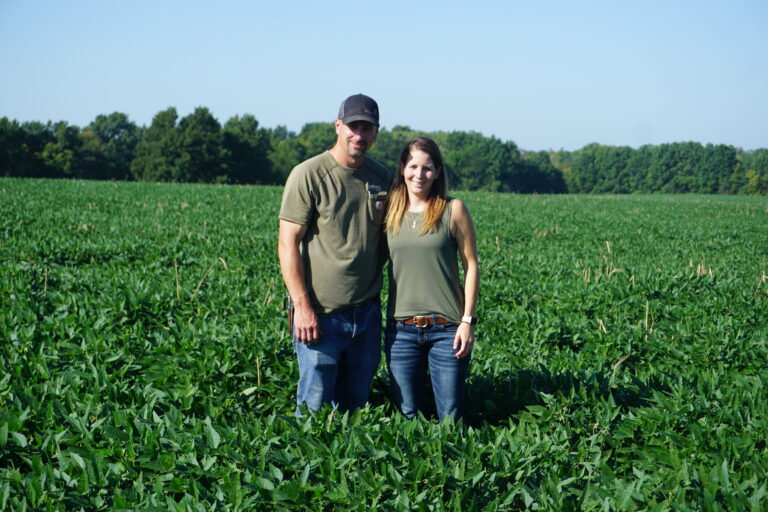Some Midwestern farmers are involved in a research project to help determine how good some practices are for the environment, and it may help them take advantage of new attempts to establish a carbon credit trade market.
The project run by Missouri Corn Growers Association and Missouri Soybean Association is looking at quantifying the reduction of carbon emissions when farmers take on practices like no-till, planting cover crops and refining fertilizer application schedules.
Matt and Kate Lambert farm in north-central Missouri and are among the farms taking part in the program. They pride themselves on being good stewards of the land, so they took on planting cover crops a few years back to help maintain the soil and prevent erosion.
“As you look out across the field, you can see the heads of the cover crops, cereal rye and triticale still kind of poking up through the bean canopy,” Matt Lambert said, pointing to his field of knee-high soybean plants. “We do it for soil health and yield. Now we’ll see what kind of carbon impact it has.”
Cover crops, which are planted between cash crops to protect the soil, are believed to aid in carbon sequestration, keeping carbon in the ground and out of the atmosphere. But exactly how much they help isn’t clear. Kate Lambert said they joined the study to get the data and separate fact from speculation.
“The ultimate goal of this project is to say what’s happening and what it’s worth, so that everybody involved can make better decisions,” Kate Lambert said.
How much it’s worth directly relates to the reemergence of carbon credit trading markets, where companies can offset their carbon footprint by paying others to reduce carbon emissions.
“There is no doubt that the carbon market potential is important and will continue to be important, especially if growers are to be rewarded, financially or otherwise, for the improvements”, said Darrick Steen, Director of Environmental Services with Missouri Soybean, “because you have to have a baseline.”
Steen said is also quick to point out that the research isn’t just about the potential money but also to know just how friendly an environmentally friendly farming practice is.
But the looming prospect of farmers selling carbon credits and getting a financial windfall has some people very concerned.
“These kinds of carbon market schemes have had a lot of problems,” said Ben Lilliston, director of rural strategies and climate change at the Institute for Agriculture and Trade Policy.
He said attempts at operating a successful carbon credit market failed 10-15 years ago. The largest problem then was big polluters were looking to absolve themselves by paying a very small amount of money to people already doing carbon reduction. Lilliston said that problem hasn’t been addressed.
He said even a 3-5 year study, like the one in Missouri, might not provide useful data because carbon sequestration isn’t a year-to-year project.
“Being able to measure precisely over time is the key. When you bring the carbon into the soil, it needs to be permanent because if it’s released, then you can’t take advantage of the carbon market,” Lilliston said.
Still, the Lamberts and other farmers like them say some data is better than none. Matt Lambert said if carbon markets start up again, he wants to have as much information as he can, so he can avoid being taking advantage of by carbon traders.
“What I’m afraid is going to happen is that those companies are the ones that are going to be making the big money off the carbon,” he said.
And even if the carbon markets don’t come back, or seem to be a bad deal for farmers, Kate Lambert said the information on carbon capture will be useful for people who for centuries have been dedicated to preserving the land that has given them their homes and livelihoods.
“All of the farmers around this area that we know and work with are extremely interested in doing what’s right. But it can’t only be what’s right for the environment, but it also has to be cost-efficient, time-efficient and available,” she said.
Follow Jonathan on Twitter: @JonathanAhl
9(MDM5MjE5NTg1MDE1Mjk1MTM5NjlkMzI1ZQ000))

